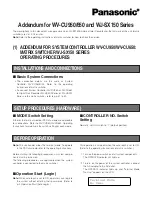
ports or small form-factor pluggable (SFP) module. If one or both of the last two port LEDs are not green,
the stack is not operating at full bandwidth.
• We recommend using only one CLI session when managing the switch stack. Be careful when using
multiple CLI sessions to the active switch . Commands that you enter in one session are not displayed
in the other sessions. Therefore, it is possible that you might not be able to identify the session from
which you entered a command.
• Manually assigning stack member numbers according to the placement of the device in the stack can
make it easier to remotely troubleshoot the switch stack. However, you need to remember that the device
have manually assigned numbers if you add, remove, or rearrange device later. Use the
switch
current-stack-member-number renumber new-stack-member-number
global configuration command
to manually assign a stack member number.
If you replace a stack member with an identical model, the new device functions with the exact same
configuration as the replaced device. This is also assuming the new device is using the same member number
as the replaced device.
Removing powered-on stack members causes the switch stack to divide (partition) into two or more switch
stacks, each with the same configuration. If you want the switch stacks to remain separate, change the IP
address or addresses of the newly created switch stacks. To recover from a partitioned switch stack, follow
these steps:
1.
Power off the newly created switch stacks.
2.
Reconnect them to the original switch stack through their StackWise Plus ports.
3.
Power on the device.
For the commands that you can use to monitor the switch stack and its members, see the
Displaying Switch
Stack Information
section.
Preventing Autonegotiation Mismatches
The IEEE 802.3ab autonegotiation protocol manages the device settings for speed (10 Mb/s, 100 Mb/s, and
1000 Mb/s, excluding SFP module ports) and duplex (half or full). There are situations when this protocol
can incorrectly align these settings, reducing performance. A mismatch occurs under these circumstances:
• A manually set speed or duplex parameter is different from the manually set speed or duplex parameter
on the connected port.
• A port is set to autonegotiate, and the connected port is set to full duplex with no autonegotiation.
To maximize the device performance and ensure a link, follow one of these guidelines when changing the
settings for duplex and speed:
• Let both ports autonegotiate both speed and duplex.
• Manually set the speed and duplex parameters for the ports on both ends of the connection.
If a remote device does not autonegotiate, configure the duplex settings on the two ports to match. The speed
parameter can adjust itself even if the connected port does not autonegotiate.
Note
System Management Configuration Guide, Cisco IOS XE Fuji 16.8.x (Catalyst 9500 Switches)
283
Troubleshooting the Software Configuration
Preventing Autonegotiation Mismatches














































